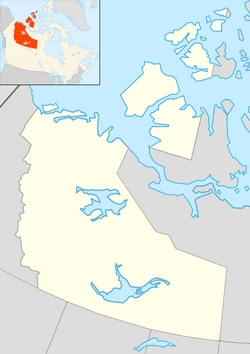Hay River Reserve
|
Hay River Reserve K'atlodeeche/Katl'odeeche First Nation Hay River Dene 1 |
|
|---|---|
| K'atlodeechee First Nation | |
| Coordinates: 60°50′01″N 115°45′57″W / 60.83361°N 115.76583°WCoordinates: 60°50′01″N 115°45′57″W / 60.83361°N 115.76583°W | |
| Country | Canada |
| Territory | Northwest Territories |
| Region | South Slave Region |
| Constituency | Deh Cho |
| Census division | Region 4 |
| Government | |
| • Chief | Roy Fabien |
| • Senior Administrative Officer | Scotty Edgerton |
| • MLA | Michael McLeod |
| Area | |
| • Land | 134.07 km2 (51.76 sq mi) |
| Elevation | 165 m (541 ft) |
| Population (2011) | |
| • Total | 292 |
| • Density | 2.2/km2 (6/sq mi) |
| Time zone | Mountain (MST) (UTC-7) |
| • Summer (DST) | MDT (UTC-6) |
| Canadian Postal code | X0E 1G4 |
| Area code(s) | 867 |
| Telephone exchange | 874 |
| - Food price index | 105.2 |
| Sources: Department of Municipal and Community Affairs, Prince of Wales Northern Heritage Centre, Canada Flight Supplement ^A 2009 figure based on Yellowknife = 100 |
|
Hay River Reserve (also known as K'atlodeeche/Katl'odeeche First Nation or Hay River Dene 1) is one of only two Indian reserves in Canada's Northwest Territories. Located in the South Slave Region, it is a Slavey community with a population of 292 (of which the majority are First Nations) at the 2011 census. The main languages on the reserve are South Slavey, Chipewyan, and English. In 2012 the Government of the Northwest Territories reported that the population was 341.
The reserve covers an area of 52 sq mi (130 km2) and claims a band membership of 600 people. The reserve is governed by a Band Council, consisting of a Chief and four Counselors, who are elected every two years on "Treaty Day". Along with the Fort Providence Dene Band the reserve operates "Evergreen Forestry Management Ltd." The reserve also runs the Ehdah Cho Store, "Tu-Cho Gha Contracting", and the "Nats’jee Keh Treatment Centre".
Primary and secondary education in the community is provided by Chief Sunrise Education Centre.
Although the Dene had been using the area around the mouth of the Hay River for many years as a fishing site it was not settled until the 1890s when Chief Chiatlo led a group to the site. Later both the Anglican, with a mission school, and the Roman Catholic Church along with trading posts and the Royal Canadian Mounted Police arrived. However, the NWT Government says that the first building in the area was the Hudson's Bay Company, followed by the Roman Catholic Mission, and then the Anglican Mission.
...
Wikipedia

